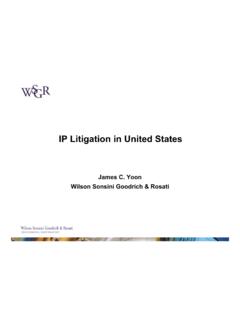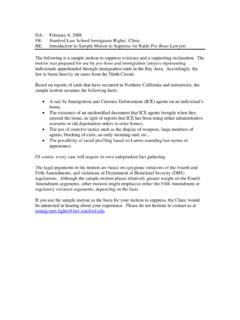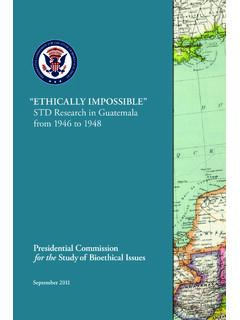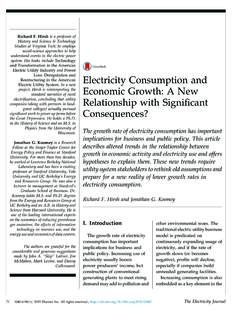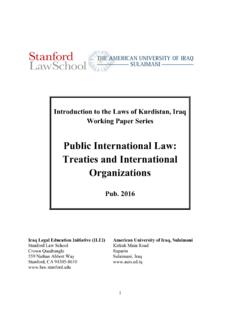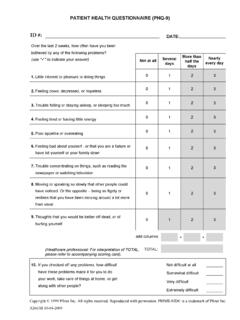Transcription of Forms of Legal Reasoning - Stanford Law School
1 LGS 210: INTRODUCTION TO THE LAWS OF IRAQ AND IRAQI KURDISTAN Forms of Legal Reasoning Materials created by: Stanford Law School s Iraqi Legal Education Initiative (ILEI) and American University of Iraq, Sulaimani (AUIS) Published 2014 Thinking Like A Lawyer 2 Table of Contents Topic Overview (to be assigned to students to read) 3-5 Discussion Questions for in-class use 6 Overview of reading and video lecture to assign 6 Overview of application exercises 6 Checklist of key concepts for instructor s use 7 Assigned Reading Attachment Application Exercise 1 8-9 Instructor s Guide to Application Exercise 1 10-12 Application Exercise 2 13-14 Instructor s Guide to Application Exercise 2 15-16 Thinking Like A Lawyer 3 Topic Overview Forms of Legal Reasoning are the methods that lawyers use to apply laws to facts in order to answer Legal questions.
2 The meaning of a Legal rule and how it should be applied are often subject to multiple interpretations. When the meaning of a Legal rule is ambiguous, lawyers use Legal Reasoning to argue for the interpretation that they find most convincing or that is most favorable to their client. The Forms of Legal Reasoning are the tools of the lawyer s trade. In this section, we learn about these tools and practice using them creatively. The first step in effective Legal Reasoning is the ability to read a Legal rule such as an article in a code and figure out how it works. Laws are often written in a way that makes them difficult to understand. Interpretation of the text of a law requires a systematic approach. Although laws take a number of different Forms , all laws have the same fundamental if/then structure: if the facts of a case satisfy a set of criteria (the elements), then the law imposes consequences (the results).
3 Below we discuss some common types of rule structures. A rule establishes a conjunctive test when it sets out a list of elements, each and every one of which must be satisfied before consequences result. The easiest way to identify a conjunctive test is to look for the word and. Civil Code Article 133(1) is an example of a conjunctive test. Civil Code Article 133(1) A valid contract is a lawful contract .. which is concluded by parties of full capacities and has an object susceptible of its Legal consequences and its attributes are valid (proper) free of any defects. A rule establishes a disjunctive test when it lists multiple elements, but only one of those elements must be satisfied to invoke the rule s consequences. Disjunctive tests are either/or tests . Penal Code Article 411(1) provides an example. Penal Code Article 411(1) Any person who accidentally kills another or causes him to be killed without premeditation so that it is the result of negligence, thoughtlessness, lack of due care and attention or lack of regard for any law, regulation or decree is punishable by detention plus a fine or by one of those penalties.
4 A rule establishes a multi-factor test when it lays out a flexible standard that requires a decision maker to consider several criteria. In contrast to the conjunctive test, the multi-factor test does not simply ask decision makers to determine if each of the listed criteria is present, it also requires them to exercise their discretion in determining the significance, or weight that should be assigned to each factor. Penal Code Article 137 is an example. Such rules may also be structured as balancing tests . When applying a Thinking Like A Lawyer 4 balancing test, a decision maker weighs competing values or factors against each other and determines which factor is more important. The balancing test in Penal Code Article 137 is emphasized. Penal Code Article 137 If there exists any aggravating circumstances in conjunction with mitigating excuses or circumstances which call for leniency, the court shall take into consideration firstly the aggravating circumstances, then the mitigating excuses and finally those circumstances which call for leniency.
5 The elements of rules might also include exceptions, or factual circumstances specifically removed from the consequences of the law. Penal Code Article 46 The right of Legal defense does not permit any person to resist a member of the public authorities in the execution of his duties even though he has overstepped the bounds of that duty while acting in good faith, unless it is reasonably feared that death or serious injury will result. Results can also be divided into different categories. Results are mandatory when they require an action. They are prohibitory when they forbid an action. They are discretionary when they empower a government official to exercise their judgment on whether or not to take a particular action. Results are declaratory when they simply state what is and is not Legal . It is not important to memorize the names of the types of elements and results described above.
6 The key skill is to learn how to break a Legal rule into smaller pieces, to understand its logical structure, and to determine if and how it applies to the facts of a particular case. Once lawyers have identified the structure of a Legal rule, they can then deploy the Forms of Legal Reasoning to interpret its meaning. Lawyers engage in five types of Legal Reasoning . Lawyers base their arguments on rules, analogies, policies, principles, and customs. Rule-based Reasoning relies on the use of syllogisms, or arguments based on formal logic. A syllogism consists of a major premise, a minor premise, and a conclusion. This structure is explained in the Scalia and Garner reading. Analogical Reasoning compares (or contrasts) the facts of a yet-to-be-decided case with the facts of a previously decided case and argues that the current case should be decided in a manner similar to (or different from) the previous case.
7 This type of Reasoning often involves the use of prior judicial decisions. For instance, an attorney arguing for a particular interpretation of a statute might point to a previous case involving the same rule and similar facts in which the court had adopted the interpretation for which the attorney is now arguing. Analogical Reasoning is less important civil law jurisdictions than it is in common law jurisdictions because civil law systems place less reliance on judicial precedent than Thinking Like A Lawyer 5 common law systems. Analogical Reasoning may also be difficult for Iraqi lawyers to use because written copies of Iraqi judicial decisions may not be widely or publicly available. A third type of Reasoning argues for a particular interpretation of a Legal rule because it would result in sound public policy, or the best outcome for society at large, not just the parties to the dispute.
8 An argument from public policy might claim that a particular outcome would promote the efficient, fair, and predictable operation of the courts. It might be based on institutional competence, or the idea that decisions should be left to the branch of government (executive, legislative, or judicial) that has the skills and expertise to best resolve a dispute. Public policy may also rely on economic Reasoning , arguing that a one outcome would promote economic growth, efficient resource allocation, or appropriate balancing of costs and benefits better than another outcome. Arguments from principle draw on common social values, such as morality, justice, fairness, equality, democracy, or personal freedom. Finally, lawyers may argue that a law should be interpreted so as not to conflict with social custom.
9 Although the Forms of Legal Reasoning may seem unfamiliar at first, most people already use elements of this type of thinking when they solve problems in their daily lives. Sound Legal Reasoning requires attorneys to pay attention to detail, to provide evidence for every conclusion, and to exercise creativity. These are skills that lawyers spend all of law School learning and the rest of their careers cultivating. Thinking Like A Lawyer 6 Discussion Questions Can you think of examples in your daily life or from other non-law classes in which you ve used the Forms of Legal Reasoning ? Overview of Reading Assignments (appended to manual) 1. Legal Writing and Analysis (2nd Edition) by Linda H. Edwards, pages 77-82 regarding rule structure. 2. Legal Writing and Analysis (2nd Edition) by Linda H. Edwards, pages 55-62 and 117-119 regarding Forms of Legal Reasoning .
10 3. Making Your Case: The Art of Persuading Judges by Antonin Scalia and Bryan A. Garner, pages 41-43 regarding syllogism. Application Exercises 1. Hazing hypothetical Use the Forms of Legal Reasoning to argue whether or not a university table tennis club has violated the university s rule against hazing. 2. Contract Law hypothetical: Shafiq assignment #1 Use the Forms of Legal Reasoning to argue whether or not a contract signed by 16-year-old Shafiq is valid under the Civil Code of Iraq. Thinking Like A Lawyer 7 Checklist of Key Concepts Structure of rules Elements Conjunctive Test Disjunctive test Multi-factor test Balancing test Exceptions Result Mandatory Prohibitory Discretionary Declaratory Forms of Legal Reasoning Rule: Syllogism Analogy Policy Judicial administration Institutional competence Economic Principle Custom Thinking Like A Lawyer 8 Application Exercise 1 Hazing Scenario First, consider the following rule from the United University ( United ) Student Handbook s section on Violations: It is the duty of all the members of the campus community to report the existence of any acts which may violate university policy.

